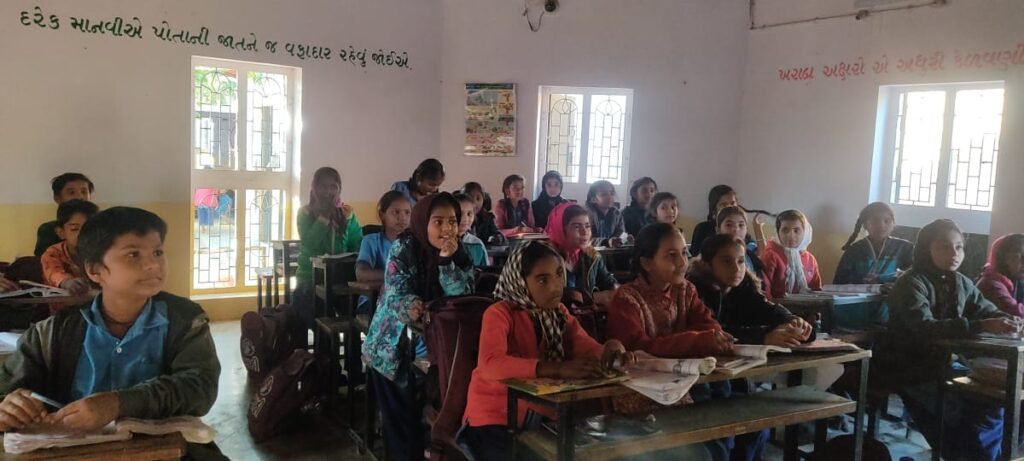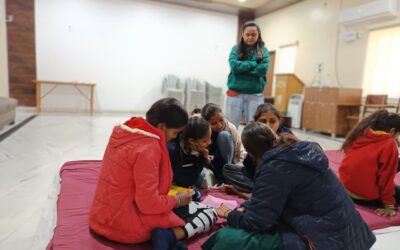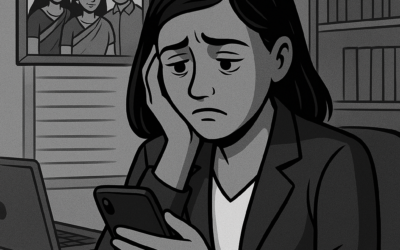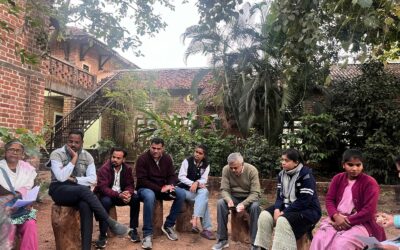Unexpected Request Rrom Nakul Mama
A few days ago, I had an hour free from office work, so I was wandering around the Gram Swaraj Sangh campus when Nakul Mama saw me. Nakul Mama, the managing director of GSS, is a retired principal, but the teacher in him never retired, so he still takes a few classes. When he noticed me free, he asked me to take a lecture for the 10th standard.
I respect him so much that I couldn’t say no. After agreeing, I asked him what I should teach. He simply said, “teach them anything.” I thought to myself, “oh great, another confusion!”
As I entered the classroom, I borrowed a social science book from one of the students since it’s my favorite subject and I thought I could teach it. However, my hopes faded when I realized the book was in Gujarati. For a few seconds, I stood there, blank, staring at the back wall. At that moment, Nakul Mama entered the classroom and saw how nervous I was. He asked the students who I was, and a few of them gave the wrong answer, because they had hardly seen me. I mostly work from the office or outside the GSS campus. Then Nakul Mama asked me to introduce myself. After my introduction, he left the classroom.
I was extremely nervous because my previous teaching experience hadn’t gone well. I wasn’t able to manage the kids—they were shouting and disturbing the class. That memory made me anxious, as I feared I wouldn’t be able to handle the students again.

I started by introducing myself and then asked the students to share their names and something they liked. However, this approach didn’t seem to work well as the students weren’t very engaged. So, I switched and asked them to share some interesting facts about Gujarat. That caught their attention, and a few of them got excited. They talked about the Rann of Kutch and mentioned “nana ne mota.” (little and big)
Curious, I asked them what the “nana Rann” was called. They replied, “It’s called Nana Rann.” I couldn’t help but remark, “How creative!” and the whole class burst into laughter.
Atankwaad
As we talked, someone casually mentioned the word atankwaad (terrorism). It’s such a heavy word to use in a light conversation that it caught my attention. I asked a kid what atankwaad meant to him. He didn’t answer. So, I decided to pose the question to the entire class. One student confidently replied, “Killing someone is atankwaad.” Intrigued, I followed up with, “Then why aren’t army personnel called atankwaadis?”
This question left them puzzled. Seeing their confusion, I proceeded and asked, “Where do you think atankwaad comes from?” Almost unanimously, “From Pakistan.” Not surprising, their answer showed how much societal biases and media influence shapes the perspective of these kids. They have absorbed the stereotypical thinking and blame an entire country for every act of violence in the world. Their perspective left me reflecting on how narratives shape young minds.
An Example
After this, I explained the definition of atankwaad to them. I told them it means creating fear in the minds of ordinary people through violence to pressure authorities into doing something. To make it easier for them to understand, I gave an example. I asked them to imagine sitting in their classroom when suddenly two armed men enter and take them hostage. These men then use the threat of harming the students to instil fear and force the authorities to act according to their demands.
After this example, the bell rang, and I had to leave the classroom. I didn’t know if the students fully understood, but this interaction had a deep impact on my mind. It made me realize that being a teacher is incredibly challenging yet often under appreciated. Despite the challenges, I left the class with a sense of fulfilment.
Their simple answers revealed the framework within which they operate. By gently challenging their beliefs with simple questions, I could encourage critical thinking—something our education system often fails to address.
What Didn’t Work Before
In my previous teaching experience, I failed to grab the attention of students. I always tried to use the activities I had learned before, without considering the mentality of the kids I was dealing with. They are very different from me, and to teach them or have meaningful conversations with them, I need to understand their perspective on life and the classroom. This time, I changed my approach. I abandoned my rigid plan and started going with the flow, which worked in my favour as the students began to engage with me.
This engagement opened the door for more dialogue and discussion. In my opinion, curiosity arises from the freedom to ask questions and losing the fear of asking ‘stupid’ ones. To spark curiosity, it’s essential to give students the freedom to ask even the silliest questions and to answer them each time without making them feel their query is unimportant or silly.
Embracing Growth
This experience helped me grow. I stepped out of my comfort zone and learned to go with the flow instead of overthinking a situation. This realization led to a meaningful interaction that left a profound impact on me. It taught me that teaching is a two-way street where engagement from both the student and the teacher is essential. This interaction also helped me understand the power of inquiry and asking questions. The simple act of posing questions can spark critical thinking among students.
It reaffirmed my belief in the transformative power of education. It taught me that teaching isn’t about having all the answers but about creating a space where questions, ideas, and understanding can flourish.




0 Comments